The Beginner’s Guide: Buster Keaton, Actor & Director
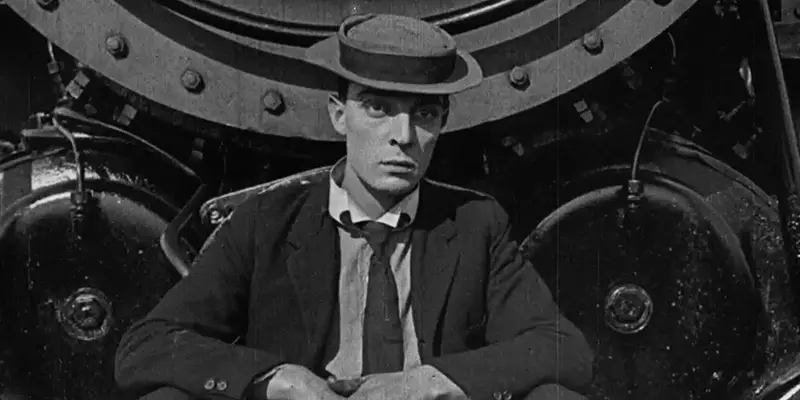
David is a film aficionado from Colchester, Connecticut. He enjoys…
When I was younger and just starting to get into classic film, I found a copy of The General at a local DVD store. Watching it later, I still remember the exact moment when I was captivated by Buster Keaton‘s unique charm and screen presence. In the film’s first extended action sequence, Keaton is chasing after a troupe of Union soldiers who had infiltrated and stolen his train, and in a series of fast-paced, whirring motions, he narrowly escapes one mishap after another. At one point, the camera focuses in on his face, and in a deadpan expression precisely shows a momentary look of confusion.
I immediately thought to myself at that moment: who was this small man with these large, soulful eyes? Why do his pensive features combined with a manic energy make his presence so alluring? I knew that I had to discover more. I found and watched most of Keaton’s silent feature films, and afterwards his many shorts. Later, I read critical essays and a book about him, and discovered that many people had similar experiences watching his films for the first time. For the last several weeks, I have watched and rewatched everything of his that I could find, completely immersing myself in the world of Buster Keaton.
As we have done many times on our site for other actors and directors, this feature will mainly function as a beginner’s guide for people who wish to be more familiar with Buster Keaton‘s work. Yet, I will also attempt to delve deeper into the man behind the iconic face, and to really get at the heart of who he was and why his work still inspires so many. I hope, above all, to do him justice.
Early Days in Vaudeville – 1895-1917
Born Joseph Keaton (the sixth in a line of Joseph Keatons) in Piqua, Kansas on October 1, 1895, Buster had the delightful fortune of being born in the right place at the right time. His parents were part of a traveling vaudeville act, and at the age of four he joined them, subsequently becoming known as the Three Keatons. The act shocked and humored audiences with Buster’s uncanny athletic ability, when, as part of the act, his father Joe Keaton would throw him across an auditorium, only for Buster to then get up, unharmed. The story goes that this is where Buster first got his name, when the magician Houdini observed him after a fall and, when the boy emerged unhurt he exclaimed “that was a real buster!”
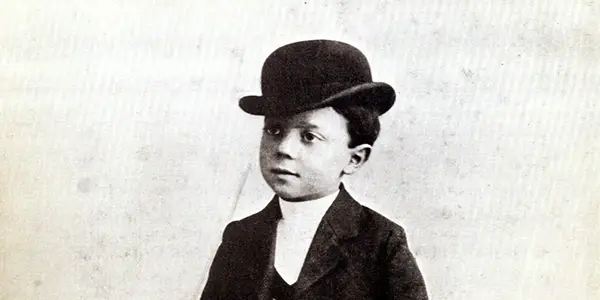
It is within vaudeville that Keaton first developed his comic deadpan style that he is now so known for (his oft-used nickname now is “The Great Stone Face”), when he gauged that the audience would laugh more when he showed no expression after his tumbles than when he would react to it.
Such a potentially harmful act would be unlikely to survive today, and even in his time it was marked by controversy, with the authorities often accusing the Keatons of abusing their son. After repeated examinations of the boy, though, it appeared that Buster only had minor scrapes or bruises even after the hardest of falls. Keaton captivated audiences with his youthful charm, athletic prowess, and impeccable comic timing, and as a result the Three Keatons were a success for many years.
At the age of 21, though, due to the elder Joe Keaton’s now actually harmful lapses caused by alcoholism, Buster left his family’s vaudeville act and set out on his own. It is here that he found his way to New York City under the mentorship of Roscoe Arbuckle, the first step towards his own eventual groundbreaking success in film.
Beginnings with Roscoe “Fatty” Arbuckle – 1917-1920
Keaton first met Roscoe Arbuckle in early 1917, when Arbuckle had already been working within the film industry. Roscoe Arbuckle (nicknamed “Fatty” due to his robustness), was a talented filmmaker in his own right; though not as brisk or athletic as Keaton, he possesses his own set of charms. With his likable, cherubic face and crafty set of skills (in one film he flings a knife in the air behind his back and it lands sharp end down on the counter in front of him), Arbuckle is still fondly remembered as one of the originators of slapstick comedy in film.
Unfortunately, his status was also marred as the victim of one of the first widely publicized Hollywood scandals, in which he was accused of the rape and manslaughter of actress Virginia Rappe (accusations that were never proven and later exonerated).
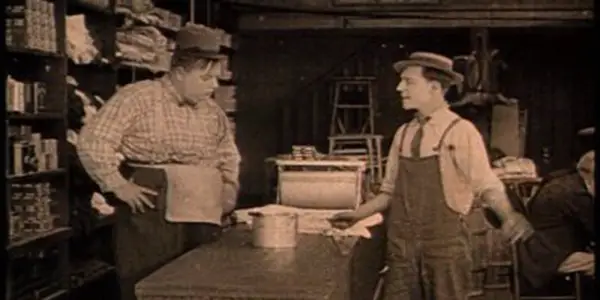
Though at first wary about embarking on a film career, Buster Keaton decided to try out his talents with Arbuckle both as a co-star and a gag writer for his shorts. Between 1917 and 1920, they starred in 14 shorts together, starting with The Butcher Boy and finishing with The Garage. Watched now, many of these shorts are nonsensical escapades, with little actual story (one short, called Back Stage, even touches on and satirizes this very aspect, with a title card explaining that the guy and girl got together simply because “we didn’t have time to develop a romantic subplot”). They usually have a simple background story merely as a starting point for a chase sequence or a crude, extended fight scene.
Keaton’s roles within Arbuckle‘s films grew greater with each passing short, as his talent became more apparent. He starts off as a casual passerby in Arbuckle’s butcher shop in The Butcher Boy, but by the final short shares almost as much screen time as Arbuckle himself. In some of them, he is even an uncredited co-director, having provided nearly as much creative input as Arbuckle in their production. My personal favorite, called The Bell Boy, stars both Keaton and Arbuckle as incompetent bellboys at a high-end hotel – one sequence, consisting of a malfunctioning horse-powered elevator, is pure physical comedy shtick.
The Arbuckle shorts are notable not only as Buster Keaton’s first onscreen appearances, but also because he emotes much more in them than in his own later films; looking back and watching them after seeing Keaton almost solely in deadpan can actually be quite alarming.
The Opening of a Studio – Buster Keaton Comedies – 1920-1928
1920-1928 is almost universally considered to be the height of Buster Keaton‘s career. After his time with Roscoe Arbuckle, which came to a close in part due to the scandal in Arbuckle‘s life, but also due to Keaton’s own desire to stand on his own, he was given his own production studio at United Artists called Buster Keaton Comedies. For the next eight years, he would produce arguably some of the finest comedy shorts and feature films of any silent director.
The Shorts – 1920-1923
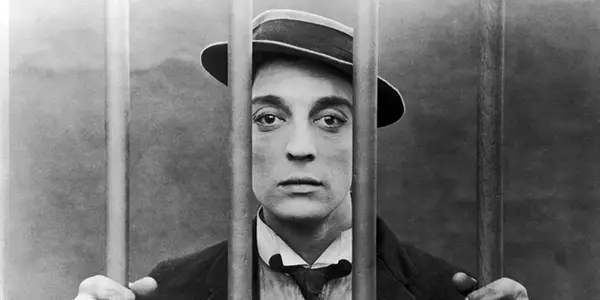
Elegantly dressed in a full black suit and tie with baggy pants, and sporting his usual flat-brimmed porkpie hat, Keaton is casually walking through a town when he notices two men in a jail cell, and peers in through the bars. Within the barred room is a criminal nicknamed Dead Shot Dan, and a photographer getting ready to take his picture for the tabloids.
Dan, noticing Keaton staring through the bars, ducks down and snaps a photo when the photographer isn’t looking. The result is the above photo – a stoic Buster Keaton seemingly behind bars. Later on in the film, this very shot is mistakenly used in a “Wanted” poster when Dead Shot Dan escapes from jail, and an oblivious Keaton strolls by, cautiously unaware of why the townspeople are running away from him in horror.
Such a brilliant setup and payoff is from Buster Keaton‘s short comedy The Goat, considered to be one of the most representative shorts of his unique style of comedy. Keaton‘s sly and meticulously crafted gags such as this one showered many of his comedy shorts, which, while not entirely free from some of the nonsensical farces that were present in Arbuckle‘s films, still helped to distinguish him as a true master of the form. His films were often based upon simple premises, but built with painstaking precision.
An example of this is his first theatrical short (though not the first that he made), called One Week. Within this short, Keaton has just married a woman and is looking to settle down in a house with her. Somebody gave them a “build-it-yourself” kit as a wedding present, and through a series of days (the one week of the title), the house slowly starts to come together – though, do to a purposeful reordering of the building instructions by a jealous admirer of the wife, the structure now appears to look more like a Picasso painting than a functional household. Such errors in structure are even more obvious once a storm hits, and the house starts to rotate on its foundation.
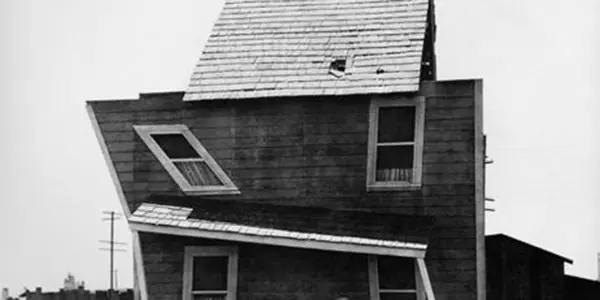
To achieve such a result, Keaton and crew had to literally build a lopsided house on top of a spinning turntable, and when a real storm came it actually turns on its axis like a dreidel. After the storm hits, Keaton subsequently attempts to rescue his current trapped house guests and wife, though the constantly rotating house makes such an act quite difficult to accomplish (not to mention, quite funny to watch).
During one sequence in One Week, Keaton, after building the house, falls out of a precariously placed second story door that leads to nothing. The fall would be one of the worst injuries he would sustain while creating his films. Yet, it was all for the gag, and true to his form, as he always would be within his own studio.
Through the course of his films, Keaton dislocated joints, broke bones, was knocked unconscious, and even sustained injuries that he didn’t know about right away (one water-flowing scene in the film Sherlock, Jr. resulted in him breaking his neck, though he wasn’t fully aware about this until an X-ray revealed the injury years later). Despite the inherent danger involved, Keaton was not one to use stunt doubles or trickery to create his gags, and was known to say that, if they could create something authentic, they would: showing his true devotion to his craft.
In Cops, often considered to be his best two-reel comedy, Keaton, oblivious and clumsy as always, runs around town, getting into a series of scrapes and unfortunate mishaps that, by the film’s conclusion, have the entire city’s police force coming after him. The film’s flurry of constant movement and clever getaways are truly magnificent. At one point he is being chased down a street and, with all the nonchalance of a man waving down a cab, grabs onto a moving vehicle heading in the opposite direction and is swiftly pulled off screen. The short film is a grab bag of finely executed maneuvers with perfectly timed precision, representative of the style of comedy that Keaton would be celebrated and eventually iconized for.
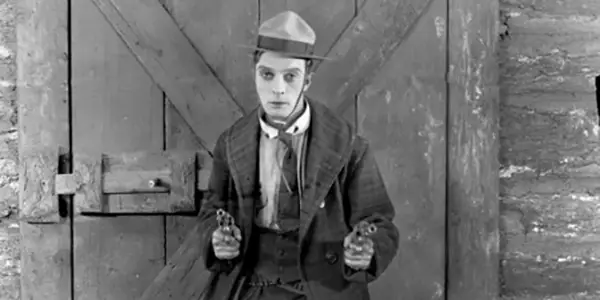
Buster Keaton’s shorts were also embellished with other elements that showed off his comedic talents, such as parody. The short The Frozen North is a direct play on the films of Western actor William S. Hart, and was made, in part, due to Hart‘s damaging remarks about Keaton’s friend Roscoe Arbuckle during his scandal. It contains many blatant quips at Hart; for example, a closeup of tears streaming down a face, which was a trademark of Hart‘s films. Not only a talented athlete with a gift for comic timing, Keaton also showed that he was skilled at imitation, showcasing his talents as a performer.
Three years and nineteen shorts later, Keaton decided to make the move past two reelers to feature filmmaking. The transition was not immediate, rather, it took some time for him to develop a feature film style that was distinctive from his laugh-a-minute shorts, which not only had very base stories and characters, but also commonly contained surrealist farces and elements that he believed would detract from a believable narrative in a feature. A full-length film couldn’t just be a longer series of pratfalls and pranks – there had to be something more.
On to Feature Films – 1923-1928
Keaton had already starred in a full-length feature back in 1920 called The Saphead, yet the film, which was neither written or directed by him, contained little of his artistic trademarks. With the exception of an energetic scene where he bounces around a stock exchange and appears to literally be flying over peoples’ heads, the film itself is merely passable.
Three Ages (1923)
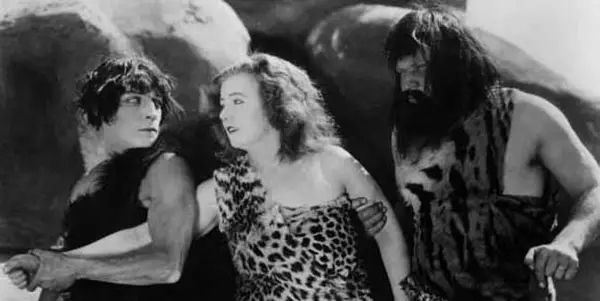
His first directorial effort, Three Ages, is a series of romantic vignettes spanning three time periods: the Stone Age, the Roman period, and present day (present day being NYC in 1923). Keaton reportedly made this his first film due to the studio’s uncertainty about his success in full-length features – as the film was basically three shorts in one, it could be split apart and sold as such if it were unsuccessful.
Within the three stories, similar things happen to each protagonist: Keaton attempts to woo a girl, is thwarted by another suitor, has to fight and outsmart the other suitor, and the stories eventually end happily ever after. Though the Stone Age segment is easily the strongest of the three, the film as a whole is not hugely impressive, suffering from a plodding pace and few laughs overall. It appears much like the work of a first-time feature film director; it wouldn’t be until his next film that Buster Keaton would truly start to shine.
Our Hospitality (1923)
The premise of Our Hospitality was clearly a satire of the Hatfield-McCoy feud of the late 19th century. Willie McKay (Keaton) is a descendant of John McKay, and is unknowingly the sworn enemy of the Canfields. As Willie grows up away from the scandal, though, he is unaware of it when he goes to claim his father’s inheritance as an adult. On the way to the South, he falls for a beautiful Southern girl named Virginia (played by Natalie Talmadge, Keaton‘s actual wife at the time).
In a Romeo and Juliet-like coincidence, Virginia turns out to be the daughter of the patriarch of the Canfield family. Though Willie does not at first know this, he must somehow find a way to win over the girl while avoiding an almost certain death at the hands of her avenging brothers and father.
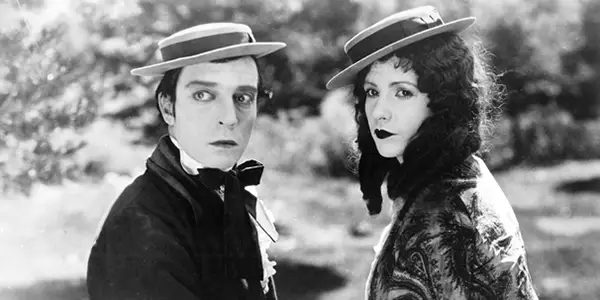
Our Hospitality is almost surely one of the first black comedies in the history of cinema. Keaton had a remarkable ability to see humor even in the darkest of circumstances, and to somehow seamlessly blend both comedy and drama, in a way that doesn’t feel forced or unnatural.
An example in the film is when Keaton’s character suddenly discovers, later on, that he is in the home of his family’s sworn enemy. However, due to the family’s time-honored tradition of being unable to harm a guest in their home, Willie is safe as long as he stays within the building. Like a kid playing tag, with their house as “base,” Keaton darts out of open doors in an attempt to escape, only to burst back in through another entrance when the Canfields chase after him, realizing that his efforts would be futile. The sequence is so cleverly filmed and acted, you almost forget the fact that Willie is literally running for his life.
The film culminates in an exciting river sequence, in which Willie must save Virginia from seething rapids before, of course, traversing off a waterfall. The resulting save and eventual conclusion is just pure movie magic.
Subsequent Hits
Over the succeeding years, Keaton created one wondrous hit after another: Sherlock, Jr., The Navigator, Seven Chances, Go West, and Battling Butler. The latter, Battling Butler, about a case of mistaken identity between our protagonist and a famous boxer, is the weakest of the bunch, yet it still contains some of his trademark, exuberant energy, such as in the final aggressive fight.
Many of his films, much like his shorts, are based upon a simple premise. Sherlock, Jr. is about a movie theater worker who wishes to be a detective. The Navigator takes place almost entirely upon a boat. Seven Chances is based upon a premise that Buster‘s character must marry somebody by 7:00 pm on his 27th birthday in order to inherent a $7 million inheritance. Go West is, bizarrely enough, about the budding friendship between a man and a cow, who is, unfortunately, about to be shipped out to be slaughtered.
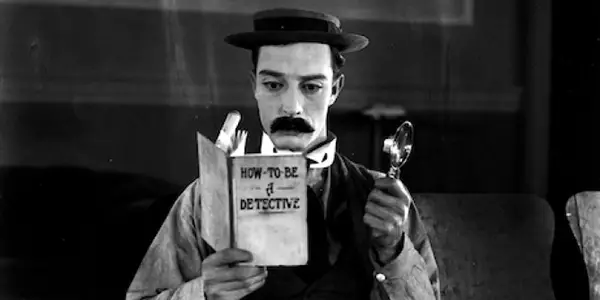
Despite their simple starting-off points, though, there is a majestic quality to each of Buster Keaton‘s films. They all present a version of the hero’s journey: a boy, wishing to prove himself, usually in order to win over the favors of a girl, endures a series of hardships and struggles, only to emerge, by the end, a fully rounded and well-deserving man. Though Sherlock, Jr. mostly builds upon a fanciful concept (much of the film is a dream-within-a-dream), it still fits within the three-act structure of a person growing and adapting through their experiences. In this case, it concerns what Keaton learns about himself through the dream, becoming someone almost entirely new by the film’s conclusion.
Each of these films usually culminate with an extended, elaborate chase sequence as well. In Sherlock, Jr. Buster Keaton, in his dream, rides across town on a bicycle to escape from gangsters, part of which he rides alone on the bike’s handlebars, unaware that the actual rider has fallen off. In The Navigator he has to fight off a gaggle of blood-thirsty cannibals, while in Seven Chances, a horde of angry women in wedding gowns, out for revenge on what they thought was an elaborate prank, chase Keaton across town and up a mountain where, on the other side, Keaton somehow wedges a series of boulders from their places, which then come careening after him in an absolutely astounding and hysterical sequence. In Go West, he dons a red Devil’s costume and, like a Mexican bullfighter, rounds up a herd of cattle that had been set loose upon a town. The time and effort spent on these sequences, especially in the realm of comedy, is almost unprecedented for the time.
The General (1926)
Nowhere is his work more lavish and well-presented, though, than in Keaton’s next film, considered to be his magnum opus: The General. The film takes place during the Civil War on the Southern side, with Keaton playing a train engineer named Johnnie Gray, who bravely takes on an entire train-full of Union spies intent on burning bridges and roads on their way North to limit the availability of Southern supplies. The film is based on an actual wartime incident, and Keaton himself even stated that he wanted it to be “so authentic it hurts.”
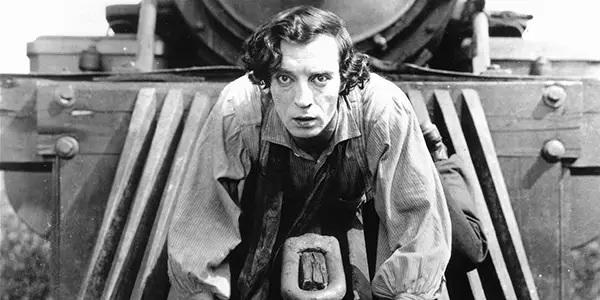
The result is a beatific creation, a masterpiece of technical mastery, extravagance, and visual splendor, along with some of Keaton’s most elaborate and expansive gags. Perched upon a train for much of the film, Johnnie must use his own inventiveness to deal with interferences on the track by the Union spies, obstructions along the side of the track, and his own clumsy nature. At one point, oblivious to his surroundings, entire fields of Union and Confederate soldiers are fighting alongside the train. When he finally looks up and notices, his look of confusion is priceless.
The General, while easily considered now to be Buster‘s reigning masterpiece, was not a huge success at the time. The giant train sets and sequences, which at the end even include actually knocking a full-sized train through a bridge, were met with a lukewarm reception and made little money for the studio. Much like many directors in their prime, Keaton fell out of favor with his producers, and though he still created another two films with United Artists, it would mark the beginning of the end for him.
College (1927)
His next film, College, is very much a comedown after the liveliness of The General. The film, which consists of the bookworm Keaton trying to succeed at athletics in order to win over the favors of a girl, is unconvincing, in part due to Keaton‘s renowned athletic ability.
The only remarkable sequence of College comes at the end when, on the run to his girl’s apartment in order to save her from a too-forward suitor, he has to use nearly every feat that he had failed at earlier when trying out for track and field (hurdles to jump over a row of bushes, pole-vaulting to launch himself into her second story bedroom, et cetera).
Steamboat Bill, Jr. (1928)
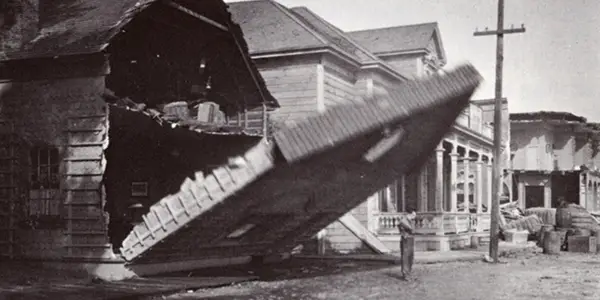
His next film, Steamboat Bill, Jr., would be Buster’s last film at United Artists. It is also one of the last great films that he ever did. The film is about a boy (Keaton), who wishes to follow in his father’s footsteps and become a great boat captain. With the clumsy, uncoordinated manner usually associated with Buster Keaton’s protagonists, though, he gets into a series of misadventures along the way. The film is most notable for its final sequence, in which the town is caught up in a cyclone, and buildings get thrown and torn down around the inhabitants.
Keaton is blown through the town, dodging buildings and almost certain death at every turn. At one point, the front of a building falls down on top of him, and he is saved only because he is standing in the spot where the top window was located. The resulting image, seen above, is brilliant not just for its timing, but because of Keaton‘s commitment to the performance – the facade of the building weighed two tons, so if he hadn’t been on that exact mark, and was even inches off, he surely would have been crushed.
Some people note that, at the time, Keaton knew that he was losing his studio, so he was more reckless than usual and even borderline suicidal. I don’t see it as too far off the mark from his typical comedic style, though; the utmost devotion and precision that he put into every film over which he had creative control.
The Loss of Creative Independence and Contract with MGM – 1928-1933
Steamboat Bill, Jr. was the last film Keaton made at United Artists, but it wouldn’t be his last great film – that is widely considered to be The Cameraman. Though he no longer had complete creative control at MGM like he did with United Artists, Keaton struggled to recapture the essence and humor of his past films, despite overwhelming pressure from his new executives. The result is a film that looks and feels like one that is wholly his own.
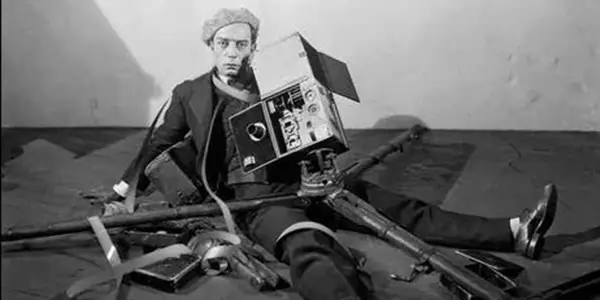
Keaton plays a photographer who yearns to work for a successful newspaper, both for his career and to win the graces of a beautiful woman who works there as secretary. His misunderstood, yet likeable protagonist is ever-present here. Keaton is chased by policemen, manages to capture on camera an entire Tong War in Chinatown despite nearly getting killed several times, befriends a monkey, and saves the girl at the end from an out-of-control boat through purely instinctual bravery. It contains nearly every pointed detail that made his films at United Artists so memorable. Unfortunately, though, MGM would no longer allow Keaton any creative input on his later films, believing that they knew best how to “remake” his image.
It is here, circa 1928, that marked the end of Buster Keaton‘s creative spurn of the last several years. Spite Marriage, his final silent film, is mostly salvageable despite an unfocused and meandering plot. But afterwards, MGM, acting in their own self-interest, created Elmer, a creation that he would later be associated with: a bumbling, idiotic, clueless buffoon. While Keaton’s protagonists were often associated with being clumsy or were blissfully unaware of their surroundings, it was never in a scornful way, and they were never unlikeable characters. Rather, you found yourself allied with them because you wished to journey along with their inevitable path to greatness.
His first sound film at MGM, Free and Easy, is perfectly representative for how misused and wasted Buster Keaton‘s talent would become. His character Elmer Butts is a manager of a budding Hollywood starlet, and, along the way, rather than help her succeed, instead discovers his own talents for show business in comedy. The film is clearly allegorical for how MGM tried to reshape the career of Keaton, in a way that would be more receptive to audiences. The irony is that, although painfully scorned now, these films were amongst the higher grossing films of his career. It’s still sad, though, to see him in roles that were surely beneath him.
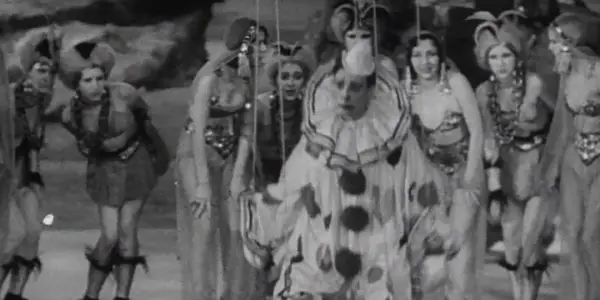
The final scene of Free and Easy finds Buster literally dressed up as a clown and, hooked up to a machine, forced to dance around on stage. He had been a clown of his own making for much of his silent film career, but now, strapped inside the business machine of MGM, Keaton was literally forced to dance around in a silly suit for the favor of audiences.
I’ve always thought that, if I could go back to one point in time, it would be to tell Buster Keaton to not, under any means, sign a contract with MGM. Either that, or somehow try to convince the executives at MGM to trust in Keaton’s creative judgment. It’s hard to see, though, how any one action could have changed the course of his career. At the time, he not only lost his studio amidst the birth of sound films, but, to add insult to injury, he was having marital problems and was about to go through a very expensive divorce from Natalie Talmadge.
The signing with MGM might have seemed to be a bad omen (contemporaries Charlie Chaplin and Harold Lloyd even warned him against it), but what better option did he have? Keaton did not have the finances to produce his own films, and he had to make a living to support not only himself but his two children and now estranged wife as well.
So, without really any other choice, he danced the corporate dance. Though it’s still interesting to see a typically silent star in a talkie (Keaton’s own deep, husky voice can be jarring yet captivating in the right environment), the writing of these films is just so far separated from his own creative efforts. A string of progressively worse films came at MGM: Doughboys, Parlor, Bedroom & Bath, Sidewalks of New York, The Passionate Plumber, and What! No Beer?, several of which teamed him with loudmouthed comedic actor Jimmy Durante. One of his later films with MGM, Speak Easily, is actually mildly entertaining, but still nothing rivaling anything he did in the ’20s.
It must have been as disheartening for Keaton after a series of these farces as it is for fans of his today, looking back at what happened to his career. Due in part to his creative fall at MGM and his expensive divorce from Natalie Talmadge, Keaton lapsed into alcoholism. He disrupted entire production schedules due to his habit and also repeatedly vocalized objections to his demeaning roles in the films. After a time, even MGM gave up on their investment, and in 1933, Buster Keaton was fired from the studio.
Comeback and Later Years – 1934-1966
A lot of people think of Buster Keaton as a tragic figure due to his fall from grace after 1928. Though it is true that, for the next 38 years he would never create another great work of art again, I don’t think it’s entirely fair to gaze back at his life through a pessimistic lens. A recent book I read about Keaton called “The Persistence of Comedy” by Imogen Sara Smith, speaks a great deal about Keaton’s career comeback, and about the fallacy of dwelling on his inferior films to the detriment of his brilliance. Keaton himself even expressed that he “had no regrets” later on in his life.
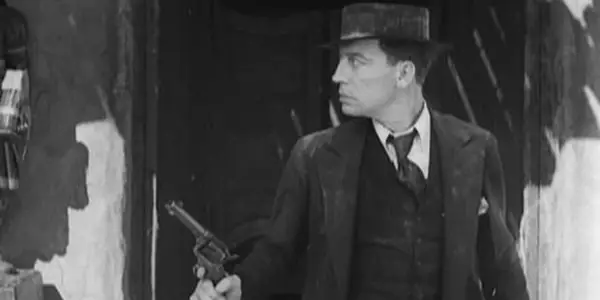
After a two-year on-and-off drinking binge, Keaton did have a somewhat resounding career comeback. He first went back to the world of two-reel comedies in a series of sound shorts for the production company Educational Pictures. Some of these, such as The Gold Ghost or Allez Oop, rival even some of his own shorts from his production studio in the 1920s. There are inklings within these films that show the potential for Keaton to have truly succeeded in sound film. An entirely dialogue-free sequence from The Gold Ghost finds Keaton within an abandoned town and, with the dilapidated structures falling down around him and his usual blend of pratfalls as a result, you almost see him as just the grown up, sound version of his early silent protagonists.
Keaton then moved on to Columbia Pictures, creating a series of less-exceptional sound shorts, before moving off to more feature films. For much of the rest of his life, he wrote gags for other films, had large to one-scene cameo roles in movies, including a memorable appearance as a card player in Sunset Boulevard (a fitting role for a movie about an aging silent movie star), and even had his own series called The Buster Keaton Show for a few episodes. He married a woman named Eleanor, whom he stayed married to until his death, and had a mostly happy last few years.
Though he never found the success or the acclaim he once held back in his heyday for anything else he made, it was also around this time, during the ’50s and ’60s, that Keaton’s silent films, some long since considered lost, were found and restored, and started to reappear at film festivals and other international circuits. Three decades after their first premiere, Buster Keaton was finally being hailed as the masterful filmmaker that there is no doubt he is today.
Legacy
There are many people who now see Buster Keaton not only as the greatest of the silent clowns, but also amongst the most distinguished of all-time directors in any genre. Roger Ebert once spoke of his “extraordinary period from 1920 to 1929, when he worked without interruption on a series of films that make him, arguably, the greatest actor-director in the history of the movies.” Though I try to stray from hyperbole, it’s easy to see why he is still, 50 years after his death and almost 100 years after his first movie, held in such high regard.
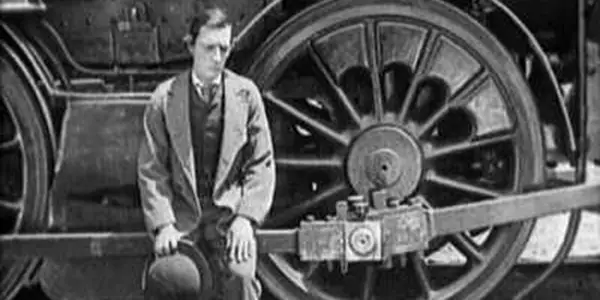
Buster Keaton was almost an otherworldly figure, as uniquely alluring in appearance and performances as he was technically proficient in his directing. His use and understanding of comedy in film at a time when people were just discovering it as an art form has made many people think of him as a man ahead of his time; indeed, as I mentioned, it was decades before he was fully appreciated.
Though we will never know how much more successful he could have been if the trio of the emergence of sound, the loss of his studio, and crippling financial burdens hadn’t hit him all at once, it’s still not enough to detract from the truly inspired work he created, or from the dynamic presence of his persona in nearly anything he worked on.
Keaton was a man of contrast: he was effortlessly talented, but perfectionistic about his work, solemn and serious in demeanor, yet somehow uncontrollably funny. How to describe such a stark contrast without romanticizing the very human behind that deadpan expression?
If there was one thing that Keaton did with absolute success, though, it was to make us laugh. A few years ago, I watched the short Cops with some younger cousins of mine who had never heard of him. Discovering Buster for the first time, I could see that same wide-eyed wonder on their faces that I once had when I first discovered him.
Buster Keaton may be an enigma, but he’s as timeless as the art of film itself. There may never be another like him.
Who is your favorite silent comedy director?
sources:
- Sara Smith, Imogen, Buster Keaton: The Persistence of Comedy. CreateSpace Independent Publishing Platform, Reprint Edition, 13 November 2013
- Ebert, Roger. “The Films of Buster Keaton,” Great Movies 2 November 2002, Accessed: August 2016
- Geoff, Andrew, “The General: the Greatest comedy of all time?” BFI Film Forever, 23 January 2014. Accessed: August 2016
Does content like this matter to you?
Become a Member and support film journalism. Unlock access to all of Film Inquiry`s great articles. Join a community of like-minded readers who are passionate about cinema - get access to our private members Network, give back to independent filmmakers, and more.
David is a film aficionado from Colchester, Connecticut. He enjoys writing, reading, analyzing, and of course, watching movies. His favorite genres are westerns, crime dramas, horror, and sci-fis. He also enjoys binge-watching TV shows on Netflix.













